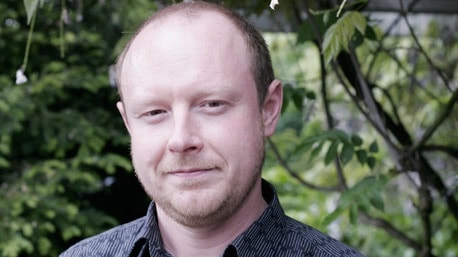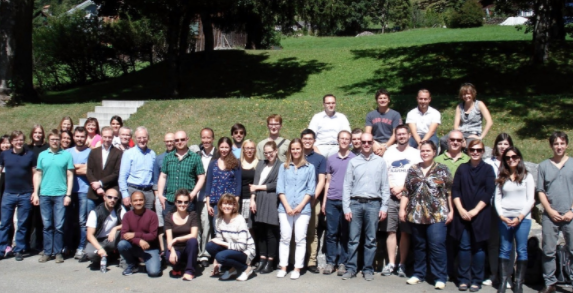--- See Christian Ruff's OHBM2017 keynote speech here: https://www.pathlms.com/ohbm/courses/5158/video_presentations/78515 --- Some say life is about choices, and to be human is to make choices in a way that sometimes defies logic. Call it intuition or instinct, there is often more than meets the eye. Such choices are what make humans human, and Christian Ruff has committed his career to uncovering the inner workings of human decision making. This is human brain mapping near the “outer limits”.
Jean Chen (JC): It’s very exciting that your research embodies a tangible way in which neuroimaging could have social impact outside of medical and biological research. Can you outline for us what path led you into this field? Christian Ruff (CR): Since my early undergraduate days, I have always been interested in why we behave the way we do, and why there are individual differences in this respect. The brain was the obvious place to look for the answer, and I started my research with clinical neuropsychology in psychiatric patients. While I found it fascinating to get to the bottom of each patient’s cognitive deficits and help patients cope with them, I came upon the impression that many of the deficits reflected idiosyncratic inabilities to cope with the test situation itself, rather than impairments in specific neuro-cognitive functions. I therefore switched to cognitive neuroimaging of executive control and reasoning in healthy, high-functioning participants, using experimental paradigms and models from cognitive psychology, cognitive science, and psychophysics. I continue to be excited about how this approach can identify brain activity that “physically“ corresponds to well-formed predictions from models of cognitive processes. Some nagging concerns as to whether the identified brain activity really controls the behaviour or simply reflects behaviour can be addressed by combining brain stimulation methods with the imaging. However, after some years of using this approach, I again felt that what I was studying did not reflect the neurobiological reasons for why participants behave the way they do. After all, in my experiments, I always told the participants what they should do, rather than letting them choose this for themselves as they would do in real life. This realization came at the time when decision neuroscience started to emerge, based on a cross-fertilization between behavioral economics, artificial intelligence, and cognitive neuroscience. The central idea of this approach immediately made sense to me - that we need to observe free choices with real-life consequences in order to understand and model the processes driving behaviour. I started to combine this conceptual approach with the neuroscience tools and concepts I had acquired in the time before, and have not regretted doing it ever since. JC: The title of your OHBM 2017 keynote lecture is “Multiple brain systems for decision making”. Without imparting too much, can you comment on whether you think at this time human decision-making can be reasonably replicated using mathematical models? CR: Within the limited scope of the tasks we use to study different aspects of decision-making, I think we are pretty good at capturing human choices with mathematical models. If we gave people choices between options that differ on a clearly defined dimension, we could for example replicate how a given individual chooses between options with different risky payoffs, how he/she chooses between options with smaller immediate or larger long-term payoffs, how much he/she chooses to maximise her own self-interest or to help others, and so forth. Where we are still limited is in our understanding of how these different facets of decision-making are triggered, weighted, and integrated in real life. For example, if you think of a typical choice situation from your recent past, it would be very hard or impossible for models to recognize by themselves whether your choice should be driven by concerns for risk, temporal aspects of the outcomes, or the consequences of your actions for other people (or combinations of these). We clearly need to make major advances on that front to start to truly understand and simulate human choices. JC: Why do concepts from economics factor into your research on decision-making? CR: If we want to understand something as complex as human decision-making, we cannot afford to ignore any sources of information on it. I therefore pay attention to all disciplines that have come up with ways to study decision-making. They all have strengths and weaknesses. For instance, Cognitive Psychology has developed well-controlled experiments that account for many different types of perceptual and cognitive limitations, but that may sometimes be too artificial to capture real-life behaviour. Behavioral economics is the opposite: It employs experiments that are close models of real-life decisions but that may sometimes not account properly for the participant’s perceptual and cognitive limitations. I try to combine these approaches, hopefully pooling their strengths. Apart from experimental approaches, economics provides interesting mathematical models that conceptualize choice behaviour as cost-benefit trade-offs. These models can be fruitfully linked with neuroscience models of how the brain processes and resolves conflict, helping us understand the neurobiological basis of behaviour in many different types of choice situations. JC: Can you give some examples of how findings from your research could be applied in everyday life? CR: Our research is basic science and is not designed to lead to direct applications. However, I hope it can provide inspiration or stepping stones for applied research. For instance, we have shown that brain stimulation of a specific area in the lateral prefrontal cortex makes people comply more with social norms, but only if they know that another human being may sanction them for violating the norm (by deducting money, similar to a fine). The stimulation had no effect when the same monetary sanction was issued by a computer. This shows that the type of norm compliance controlled by these processes may be much more sensitive to the projected social consequences of norm violations than to the purely material consequences. Thus, in situations whereby it is required to prevent violations of specific social norms, it may be more helpful to provide collective social feedback rather than to slap a monetary fine on offenders. However, concrete policy recommendations in this respect would of course require further applied studies. JC: What do you think is the most exciting body of work coming out of your lab in the past 5 years? CR: I am excited about all the research we do, but it appears that there are two major lines of work for which we get most feedback from the community and the public. One of these employs brain stimulation combined with imaging to understand our brains, which functions through processes dedicated to complex, uniquely human social behaviors. Until now, we have found evidence for such processes in the domains of norm compliance, honesty, and strategic social behaviour. The second line of work identifies generic neural computations that underlie both preference-based and perceptual decisions. These types of behaviours have traditionally been studied in isolation, but our work shows that there are shared neural-choice computations and shared principles of how both types of information are processed. This is important as it helps us understand how the brain can flexibly combine affective and perceptual information to control actions. JC: How do you foresee the evolution of your research program for the next 5 years? 10 years? CR: I hope to be able to merge the two lines of work mentioned above. Even though our brain appears to contain dedicated processes for social behaviour, we usually effortlessly combine social considerations with perceptual and preference-based information to take decisions. I therefore plan to model and study in much more detail to what degree abstract social information is processed during decision-making in ways that can be integrated with basic sensory and affective information. This will require unifying the separate computational models that have emerged in these different domains, understanding a lot more about their correspondence to both metabolic and electrophysiological measures of neural function, and establishing possible causal relationships. I also hope to tackle the question about individual differences more directly, by going back to my roots and investigating whether behavioural symptoms of psychiatric disorders may reflect disruptions in the neural choice processes identified in our research. JC: Do you feel that the current neuroimaging methods are sufficient for achieving your goals? If not, how do you hope they can improve? CR: I think no-one disputes that all of our current neuroimaging methods are limited. It is sometimes frustrating that we have to combine several techniques just to get a low-resolution glimpse of the location, timing, and causal role of neural processes. In the fantasy world, all these aspects would be covered by a single non-obtrusive method. Since this is probably not going to happen, I feel pretty comfortable addressing my questions with the present multi-modal neuroimaging and stimulation approach. The biggest limitation here is that the current brain stimulation and electrophysiological methods are largely limited to the cortical surface. This prevents us from fully integrating them with fMRI and from addressing many interesting questions. I have mild hope that this may change in the future, but do not want to be overly optimistic. JC: Can you provide two pieces of advice to new/emerging/aspiring scientists? CR: My first advice – at the danger of sounding cliché – is to follow your own instincts and passions when choosing the fields and questions you want to study. What matters is that you find a question fascinating - not whether it is en vogue, low-hanging fruit, certain to get you a grant, or the favour of a supervisor. Life is too short for studies targeting questions that you do not care about. Such studies are unlikely to keep you motivated and therefore will get neither you nor our knowledge anywhere. My second advice is to value other people’s criticism of your work and use it to move forward. We have a tendency to become very defensive about our ideas and studies, which is understandable given the hard work necessary to develop them. However, this tendency can prevent us from truly listening and taking on board valuable information about whether and how other people understand our work. This is what ultimately matters for your science! Thus, a paper rejection with good comments can ultimately be more valuable than a clean acceptance, and a talk that triggers a heated and confrontational discussion can benefit you more than a muted applause without any questions. We thank Christian Ruff for his time answering these questions and participating in the video interview. We look forward to attending his Wednesday keynote on “Multiple brain systems for decision making” on Wednesday 4:15pm in Ballroom AB.
0 Comments
Your comment will be posted after it is approved.
Leave a Reply. |
BLOG HOME
Archives
January 2024
|


 RSS Feed
RSS Feed